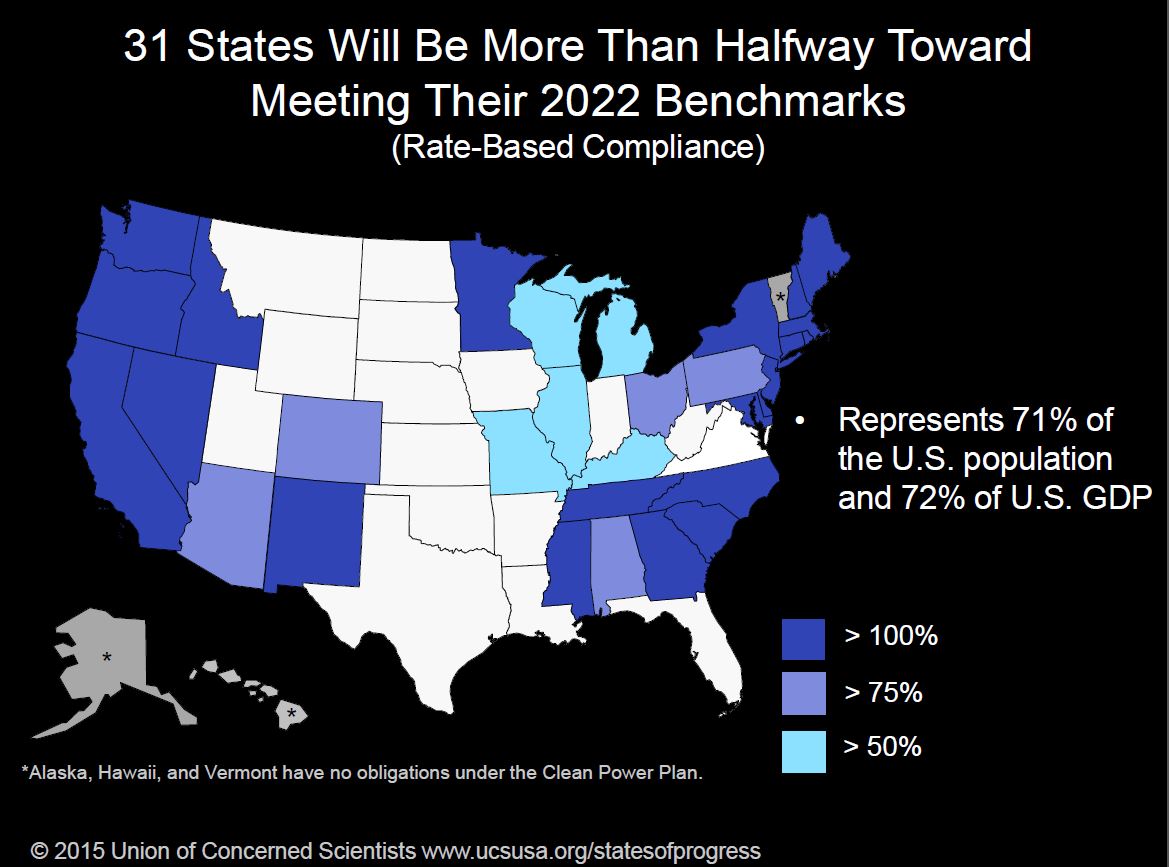A new study by the Union of Concerned Scientists underscores an intriguing dichotomy in the battle over climate change: While many states are bitterly contesting the Obama administration’s new rule for reducing carbon emissions over the coming decades, many of those same states are already well along in meeting the new targets.
Related: How ‘King Coal’ Could Swing the 2016 Election
Long before the Environmental Protection Agency finalized the Clean Power rule last week demanding a 32 percent reduction in carbon dioxide emissions by 2030 from 2005 levels, many states were whittling away at the pollution that contributes to global warming by closing old coal-fired power plants, switching to cleaner renewable energy sources and improving industrial energy efficiency.
While the efforts differed greatly from one state to another – and lacked the uniformity that can be achieved through a national standard like Clean Power – the states nonetheless demonstrated what could be accomplished without direct prodding from Washington.
The detailed analysis by the Union of Concerned Scientists, a premier environmental group that supports the Obama administration’s new regulation, found that 31 states have already made commitments that will significantly reduce their carbon outputs and 21 are on track to actually surpass the EPA’s first benchmarks for 2022.
Moreover, 20 states are effectively more than halfway toward meeting their 2030 Clean Power Plan target, with 16 set to surpass those targets.
Related: Which States Get Hit Hardest by Obama’s New Energy Rule?
“What it tells us is that this clean energy transition is already underway, and a lot of states have already made decisions that have started them down this path,” Jeremy Richardson, Senior Energy Analyst with the UCS, said in an interview. “Our analysis shows that those states that have been leaders are actually really well positioned to comply with the goals that are set forth by the final rule.”
What’s more, some of the states that are in the forefront of trying to block the new EPA rules – including Ohio, Michigan, Georgia, North Carolina and Alabama – are well along in meeting the new federal targets, according to the UCS analysis.
In all, 15 states led by the attorney general of West Virginia asked a federal court on Thursday to temporarily block the new carbon emission goals while they mount a full legal challenge to the rule, according to the The Wall Street Journal.
Many of those states are highly reliant on coal-generated power and emit high levels of carbon emissions that directly contribute to global warming. They face the toughest economic challenges in converting to alternative energy sources.
Related: Obama: This May Be ‘The Last Generation’ That Can Stop Climate Change
Yet according to the new report, Ohio already is on track to meet 82 percent of the EPA goals by 2022 based on rate of emissions, Michigan is 63 percent of the way there, Arizona 84 percent and Georgia, North Carolina and South Carolina could end up achieving twice the federal target.
“That’s really sort of an interesting look at how far along states are towards getting to the targets,” said Richardson. “What we analyzed for this rule was just looking at existing policies that states already have in place.”
In short, states have achieved a lot on their own, while Congress and the Obama administration bickered for nearly seven years over new policies for addressing global warming. “But I think the federal rule is critical because it puts us nationally on a pathway to reducing our emissions,” Richardson noted. “It recognizes the leadership that certain states have already taken to reduce emissions, but it is really trying to bring everybody along in that pathway towards a clean air economy.”
In issuing the final rules, the EPA gave the states two extra years to meet the new goals and granted them broad flexibility in implementing the plan. That means states will be allowed to exercise discretion in how best to manage the emissions — including a carbon tax, investments in renewable energy sources and a multi-state emissions trading system.
Related: The High Cost of Climate Change – Wildfires Burn through the Forests Service Budget
Opponents view the new rule as an illegal power grab by the Obama administration that will force states highly dependent on coal-generated electricity to spend large sums to upgrade or close older power plants, increase utility rates and lay off workers.
A new Morning Consult poll found that pluralities of registered voters believe that the new Clean Power Plan will result in higher energy bills, although 63 percent support the rule.
“These regulations, if allowed to proceed, will do serious harm to West Virginia and the U.S. economy, and that is why we are taking quick action to bring this process to a halt,” West Virginia Attorney General Patrick Morrisey, a leading opponent of the rule, said recently.






